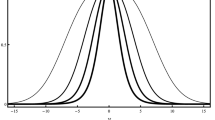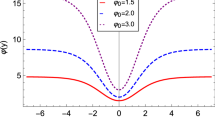Abstract
In this work we study a Hořava-like 5-dimensional model in the context of braneworld theory. The equations of motion of such model are obtained and, within the realm of warped geometry, we show that the model is consistent if and only if λ takes its relativistic value 1. Furthermore, we show that the elimination of problematic terms involving the warp factor second order derivatives are eliminated by imposing detailed balance condition in the bulk. Afterwards, Israel’s junction conditions are computed, allowing the attainment of an effective Lagrangian in the visible brane. In particular, we show that the resultant effective Lagrangian in the brane corresponds to a (3+1)-dimensional Hořava-like model with an emergent positive cosmological constant but without detailed balance condition. Now, restoration of detailed balance condition, at this time imposed over the brane, plays an interesting role by fitting accordingly the sign of the arbitrary constant β, insuring a positive brane tension and a real energy for the graviton within its dispersion relation. Also, the brane consistency equations are obtained and, as a result, the model admits positive brane tensions in the compactification scheme if, and only if, β is negative and the detailed balance condition is imposed.

Similar content being viewed by others
Notes
We will return to this point at a later time and define the detailed balance condition.
Remember we are considering Z 2 symmetry in the y direction.
Obviously, it is in accordance with our previous vacuum case particularization.
It is worth saying that, at least regarding ultraviolet behavior of the propagator, there is a necessity of the detailed balance condition only in the quadratic terms in curvature, a soft detailed balance condition, despite the presence of higher order terms in the action, as shown in Ref. [5].
References
K.S. Stelle, Phys. Rev. D 16, 953 (1977)
P. Horava, Phys. Rev. D 79, 084008 (2009)
D. Orlando, S. Reffert, Class. Quantum Gravity 26, 155021 (2009)
F.S. Bemfica, M. Gomes, Phys. Rev. D 84, 084022 (2011)
F.S. Bemfica, M. Gomes (2011). arXiv:1111.5779
L. Randall, R. Sundrum, Phys. Rev. Lett. 83, 4690 (1999)
M. Abdalla, M. Guimaraes, J.M. Hoff da Silva, J. High Energy Phys. 1009, 051 (2010)
J.M. Hoff da Silva, M. Dias, Phys. Rev. D 84, 066011 (2011)
G.W. Gibbons, R. Kallosh, A.D. Linde, J. High Energy Phys. 0101, 022 (2001)
F. Leblond, R.C. Myers, D.J. Winters, J. High Energy Phys. 0107, 031 (2001)
W.D. Goldberger, M.B. Wise, Phys. Rev. Lett. 83, 4922 (1999)
M. Henneaux, A. Kleinschmidt, G.L. Gomez, Phys. Rev. D 81, 064002 (2010)
D. Blas, O. Pujolas, S. Sibiryakov, J. High Energy Phys. 10, 029 (2009)
R.M. Wald, General Relativity (The University of Chicago Press, Chicago, 1984)
W. Israel, Nuovo Cimento B 44, 1 (1966)
T. Thiemann, Modern Canonical Quantum General Relativity (Cambridge University Press, Cambridge, 2007)
Acknowledgement
This work was partially supported by Fundação de Amparo à Pesquisa do Estado de São Paulo (FAPESP) and Conselho Nacional de Pesquisas (CNPq).
Author information
Authors and Affiliations
Corresponding author
Appendix: Evaluation of \(\tilde{\varLambda}\)
Appendix: Evaluation of \(\tilde{\varLambda}\)
From (30a), (30b), it is straightforward to obtain
where the first term in the right hand side of the above equation can be found in (33). The more intricate term is \(\tilde {q}^{ab}V_{ab}\). By defining \(v_{ab}\equiv\tilde{N}f_{ab}\) (\(v\equiv \tilde{g}^{ab}v_{ab}\)) and by keeping in mind that v 4i =0, it can be expressed as [see (20)]

We have benefited from the identity
Note that
while
Purely spatial indices lead to
Although v i4=0, this is not true for \(\tilde{D}_{a}v_{4i}\). The important relations one needs at this point are



together with \(\tilde{D}_{4}v_{i4}=0\). With those relations in mind one is able to get



and

By collecting the results (90)–(96) into (85), dividing it by \(\tilde{N}=\sqrt{w}N\), writing \(v_{ab}=\sqrt {w}Nf_{ab}\) and then inserting it into (84) one finally gets the result quoted in (78).
Rights and permissions
About this article
Cite this article
Bemfica, F.S., Dias, M., Gomes, M. et al. Braneworlds scenarios in a gravity model with higher order spatial three-curvature terms. Eur. Phys. J. C 73, 2376 (2013). https://doi.org/10.1140/epjc/s10052-013-2376-z
Received:
Published:
DOI: https://doi.org/10.1140/epjc/s10052-013-2376-z




